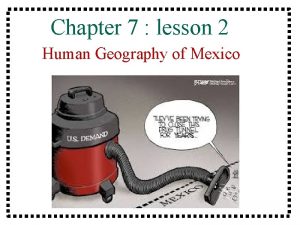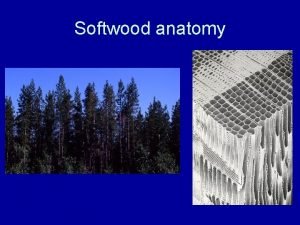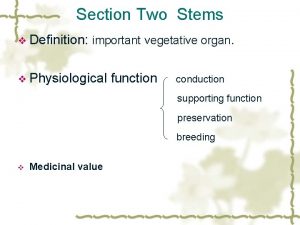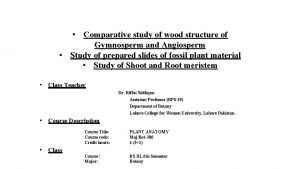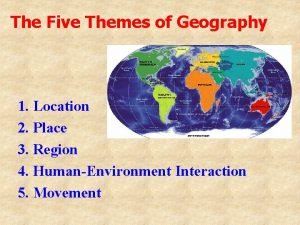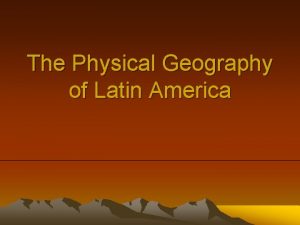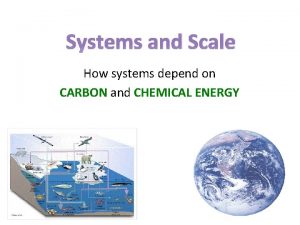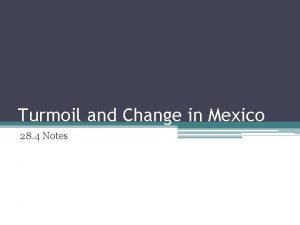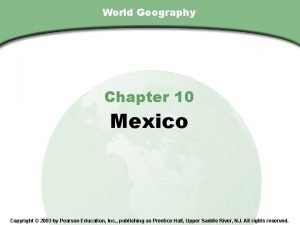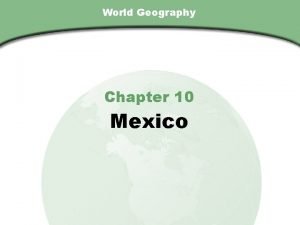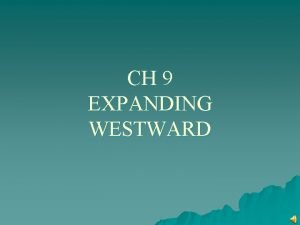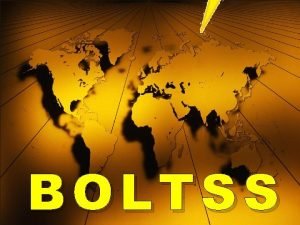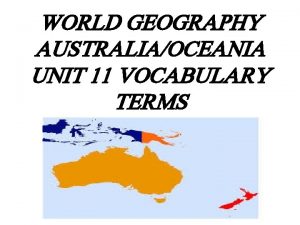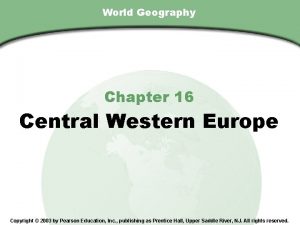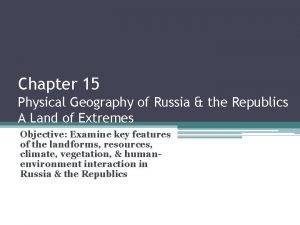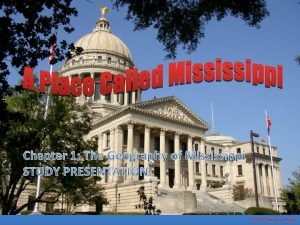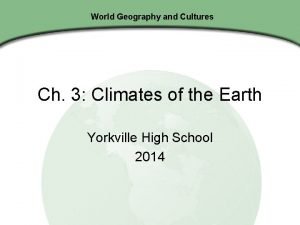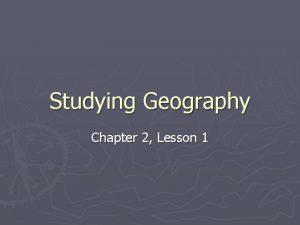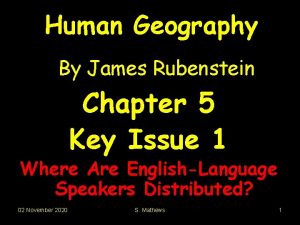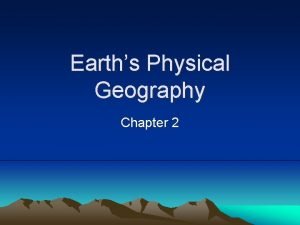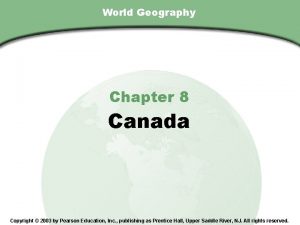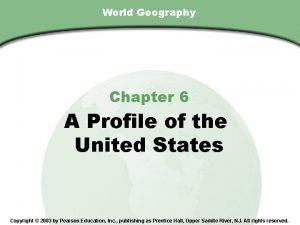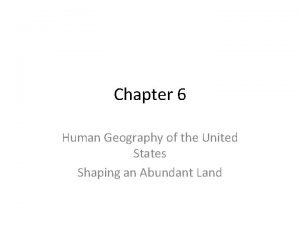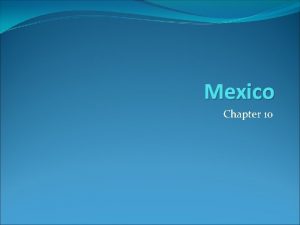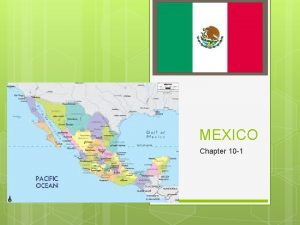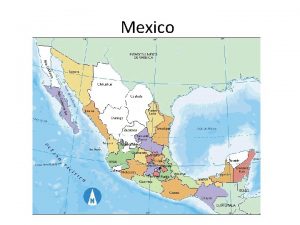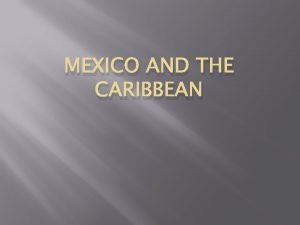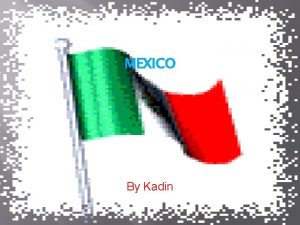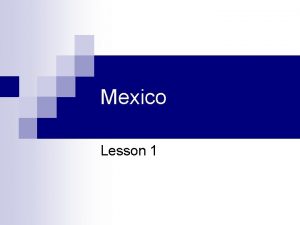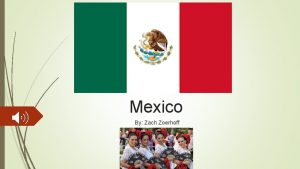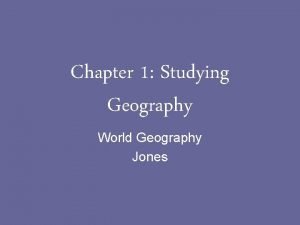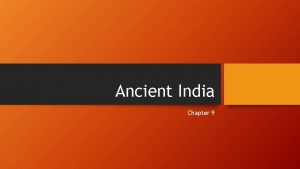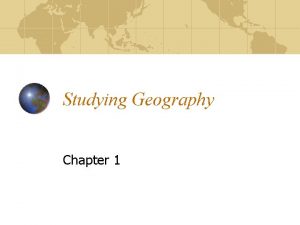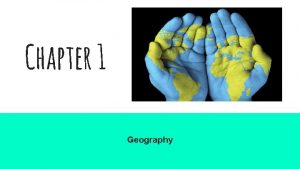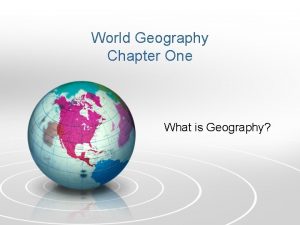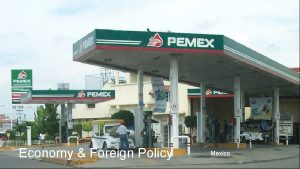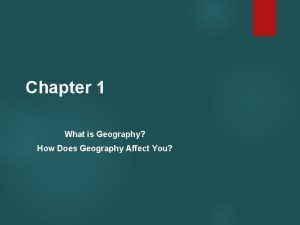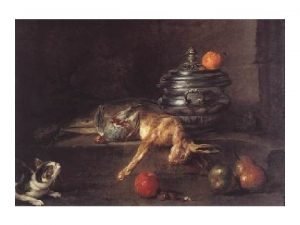Mexico Wood Chapter 6 Geography of Mexico Does







































- Slides: 39

Mexico Wood Chapter 6

Geography of Mexico • Does the geography of Mexico contribute to more cross-cutting or coinciding cleavages in the country?

Geography – Climate

Geography – Population • 75 -80% live in Urban settings • Mexico City 21 M of 121 M pop • 65% Mestizo • 25% Amerindian • 10% European • 90% speak Spanish

Geography – Resources

Geography – Oil & Natural Gas

Geography – Political

Geography – Economy • GDP $1. 134 T $10, 600 ($17, 900 PPP) • 15% Agriculture • 25% Industrial • 60% Service • Gini coefficient is. 47 • Top 10% have 38% of wealth • 42% under government poverty line • 33% less than $5 a day

Geography of Mexico • Does the geography of Mexico contribute to more cross-cutting or coinciding cleavages in the country?

History of Mexico • How have historical events made major contributions to the creation of the Mexican nation -state, and where does the current government of Mexico derive its legitimacy from?

History – Beginning to 1810 • Over 3000 years of established history • Olmec, Mayan, Toltec, Aztec • 1519 discovery by Cortes leads to Spanish rule • Catholic Church heavy influence on socializing natives to Spanish life • Authoritarian rule by the crown through appointed officials • Strict class structure based on blood and birth origins • Encomienda system and church influence made slavery not feasible

History – 1810 to 1876 • Padre Hidalgo leads peasant uprising against Spanish rule (executed) • Spain grants Mexican Independence in 1821 but problems • • Instability and legitimacy issues Rise of Military Domination by US (Texas issue) Democracy (Juarez) vs Authoritarianism (Military)

History – 1876 to 1910 • Porfirio Diaz takes control after coup d'état and promises democracy (nope) • Stability • Authoritarianism • Foreign Investment from United States • Income Inequality, but advancement • Reign ends with the Revolution of 1910

History – 1910 - 1917 • Calls for an election boiled over, and by 1911 Diaz abdicated • Warlords (caudillos) control regions through patron-client system • Emiliano Zapata and Pancho Villa • Constitution of 1917 • Establishes three branches of government • Fair competitive elections • All subsoil rights (oil) are nationalized

History – 1917 - 1934 • Constitution didn't end problems. Assassinations still common. • Church fought the liberals who sought to end Catholic influence • Cristero Rebellion led to the deaths of hundreds of thousands • President Calles sought agreement among caudillos for stable rule • Partido Revolucionaro Institucional (PRI) created • President could only serve on six-year term sexenio • Others would serve in powerful government positions • Regions would take turns to share power

History – 1934 – 1940 • Lazaro Cardenas succeeded Calles and brought great change to Mexico • Redistribution of land into collective land grants (ejidos) • Co-optation of industry under government control (PEMEX) • Infrastructure projects throughout (roads, electricity, etc) • Brought new factions into government with peasant and union groups • Import substitution – high tariffs, subsidies, and govt ownership of industry • Increased the power of the presidency, but allowed peaceful transfer

History – 1940 - 1980 s • After Cardenas, the concept of Pendulum Theory begins • Socialist policies to promote egalitarianism followed by economic liberalization, back to socialist policies • Moderate Tecnicos seize government policy in the 1970 s • In the 1980 s, neoliberalism policy institutes a free market, balanced budget, privatization, free trade with a laissez-faire regulation policy

History – 1980 s - present • The "Mexican Miracle" describes growth of country 1950 -80 • Fueled by rising oil and natural gas prices, cracks in power are seen when oil prices fall in 1982 • • Rift between politicos (camarillas) and tecnicos begins in PRI NAFTA creates new markets for Mexican products 1988 elections many feel were corrupt, led to electoral reform 2000 Mexico elects first non PRI candidate for President

Government Institutions – Executive • National Election with no run-off • Winner usually earns a plurality, not a majority (43%, 36%, 38% ) • 1 six year term (sexenio) • Party primaries have chosen candidate since 2000 • Appoints cabinet and many top bureaucrats (camarillas system) • Appoints judges for Supreme Court at beginning of sexenio

Government Institutions – Bureaucracy • • • 1. 5 million government employees, mostly in Mexico City Teachers and para-statal (PEMEX) workers account for rest Low pay, but high job security Under PRI, civil service was tied to patron-client networks When new sexenio took office, bosses took camarilla to new post

Government Institutions – Legislative • Congress de la Union - Bicameral legislature • Senate – 128 members 6 year terms • three per state plus Mexico City with a unique 2 + 1 model • 32 in national proportional representation model • Chamber of Deputies – 500 members 3 year terms • 300 are single member district, first-past-the-post • 200 are proportional representation from regional vote • May not run for re-election (changes in 2018 to allow 12 total years)

Government Institutions - Legislative Deputies 2012 16% PRI 41% 20% Deputies 2015 PRI 40% PAN PDR Other 23% 27% PAN PRD 11% Others 22%

Government Institutions – Judicial • Based on Napoleonic (Code)Law • Hierarchy of courts with state courts a bottom and appellate courts above • Supreme Court of Justice of the Nation • Has judicial review (8/11) but does not use it • Tradition of resignation at end of sexenio has stopped since election of 2000 • Overall Judiciary is seen as corrupt and suseptible to bribes at the local level

Government Institutions – Military • All leaders of Mexico has military background until 1940 s • Calles and Cardenas instituted plan of rotating generals that has lessened role of military in political affairs • Military has been used against drug cartels, but corruption is an issue • Federal Police has greatest reputation among law enforcement • Calderon (2009) increased efforts to legitimize rule of law among enforcement

Political Institutions – Political Parties • Partido Revolucionario Institucional (PRI) • Won every gubernatorial, legislative, and presidential election until 1989, 97, 2000 • Coalition of elites (caduillos) who used co-optation when legitimate rivals appeared (1968 student protests) • Patro-client system (camarillos) ensured support of party platform • 85 -90% of electorate usually voted PRI until 1988 (rigged election) • As elections became more legitimate, PRI has lost power and must share with PAN and PRD • PRI supporters are likely rural, less educated, and older

Political Institutions – Political Parties • Partido de Accion Nacional (PAN) • Center-right opposition to PRI • Founded in 1939 was tolerated to show "democracy" • 2000 Vicente Fox became first non-PRI to win presidency, and Calderon wins 2006 • Seen as pro-business, pro-church, and favors regional autonomy • Most support is in the north • PAN supporters are likely urban, middle to upper class

Political Institutions – Political Parties • Partido de la Revolucion Democratica (PRD) • Center-left opposition to the PRI • Splinter party from PRI, due to electoral corruption in 1988 election (Cardenas) • • Most socialist party members joined after 1988 Lost close election in 2006 by less than 1%, protests by Obrador Smaller representation that PAN or PRI in legislature PRD supporters tend to be younger, politically active, educated; Mexico City

Political Institutions – Elections • Open political system that allows multiple parties, but today is dominated • • • by three (PRI, PAN, PRD) 1920 -2000 only PRI candidates were elected president Elections rigged in 1988 to prevent PRD candidate from winning Since 1994 (observed) elections considered competitive and fair Mix of FPTP and PR for legislature Mid-Term elections can change balance of power in Chamber of Deputies Independents can now run (2015)

Political Institutions – Interest Groups • History of co-optation by government of groups (1968 student group) • State corporatism has made elites extremely wealthy • Unions were powerful until 1980's, but have seen decline of political power • Nieto arrested leader of Educational Workers Union and initiated reforms • Ejido groups have lobbied for less governmental control • NAFTA led to an increase of environmental group presence

Political Institutions – Media • Ranked 149 out of 180 in world for Press Freedom • Government controlled media until 1980's by buying ads, subsidizing salaries • International organizations are freely allowed into country CNN, BBC • Criticism of Pres. Fox was tolerated • Presidential debates are now televised • Most problems come from drug cartels, however firing by MVS Radio of Carmen Aristegui over comments directed at Mrs. Nieto have led to concern

Civil Society – Cleavages • Urban vs Rural – PRI was intended to control a largely rural, illiterate society; Mexico is 75% urban and literacy rate is 90% • Social Class – Growing middle class helps PAN support, poor split between PRI and PRD • Mestizo vs Amerindian – 30% identify as Amerindian in Mexico and those tend to be poor • North vs South – Northern economy based on trade with US and favor market oriented policies; South less educated, but fearful of PRI central government as repressive

Civil Society – Protests • Co-optation was strategy of the PRI from 1930's on • Tlatelolco Plaza – 1968 protests led to death of over 200 students • Government gave student leaders positions in government and increased spending on social services including antipoverty programs • Zapatista (EZLN) uprising – anti –NAFTA non-mestizo control of Chiapas • Militant at first, political now • Jalisco New Generation – de facto control of town on May 1 st 2015 • Formed from remnants of other cartels, and even tried to gain legitimacy; concerns over govt policy

Civil Society – Voting • Region – PRI is only party with true national appeal; PRD in south, PAN in north • Poverty/marginalization - PRI have counted on the poor due to the many govt. programs handed out, PAN increased them from 200012, so the poor are not a sure vote for PRI anymore • Age – the PRD is youth based, and PRI pulls from the older generation

Policies and Issues – The Economy • Economy has steadily grown since the 1940's "Mexican Miricle" • Income disparity is a key economic problem (40% of bottom earn 11%) • Urbanization has created rushed, poorly planned cities without access to electricity, running water, sewer, mass transit, and pollution • Oil Crisis of 1982 put Mexico's debt at 70% of GDP • Sharp cuts in government spending (austerity) • Privatization of state owned enterprises

Policies and Issues – The Economy • Massive earthquakes in Mexico City September 1985 added to this – in response hundreds of communities organized rescue efforts, soup kitchens, shelters, rehab initiatives; led to growing sense of political empowerment and learned they could solve their problems better than government could

Policies and Issues – The Economy • PEMEX – State owned oil company • Oil production in Mexico was falling due to outdated capital and lack of exporation • Pres Fox and Calderon had tried to privatize PEMEX but was blocked by the legislature • Calderon wanted to create independent contracts but blocked again • Pres Nieto has been able to sell rights to foreign companies, somewhat lessening the monopoly of PEMEX

Policies and Issues – Foreign Policy • Maquiladora – factory towns on the border of the US created in 1960 s • NAFTA (95) – greatly increased the number and size of maquiladora • 20% of Mexico's industrial labor live on the US border • GATT/WTO - 1986 Mexico joins GATT; becomes WTO 1995 • Immigration (Emigration) Policy – Agreements with the US over illegal emigration from Mexico have been held up; immigration from Central America is issue "La Bestia"

Policies and Issues – Drug Trafficking • Estimated 450 k people employed • $25 -30 billion in sales • Calderon pledged to stop the drug cartels and fought police corruption • Efforts only led to increased violence and instability in the North • The military was sent in as an emergency measure, but remains in some towns

Policies and Issues – Electoral Reform • 1920 s-1988 PRI dominated elections through broad consensus, cooption, and at times fraud (1988 I'm looking at you buddy) • 1990 creation of the Instituto Federal Electoral (IFE) • Reforms for fair elections include: Campaign finance restrictions, critical media coverage, International watch teams, Election monitoring • 1994 is considered Mexico's first free and fair election, also assassination of PRI's candidate not so good. . .
 Guided reading activity lesson 2 human geography of mexico
Guided reading activity lesson 2 human geography of mexico Longitudinal tracheids
Longitudinal tracheids Roots method of vegetative propagation
Roots method of vegetative propagation Gymnosperm structure
Gymnosperm structure Esau wood poem
Esau wood poem Wood wood teenager
Wood wood teenager Five themes of geography region
Five themes of geography region South america highlands
South america highlands Frq ap human geography format
Frq ap human geography format 5 themes of geography ap human geography
5 themes of geography ap human geography Proruption ap human geography
Proruption ap human geography Why does ethanol look like water but behave more like wood?
Why does ethanol look like water but behave more like wood? Chapter 7 wood joints
Chapter 7 wood joints Turmoil and change in mexico
Turmoil and change in mexico Chapter 10 section 1 mexico
Chapter 10 section 1 mexico Chapter 10 section 1 mexico
Chapter 10 section 1 mexico The war with mexico chapter 9 section 4
The war with mexico chapter 9 section 4 Boltss
Boltss Ap human geography chapter 11 vocab
Ap human geography chapter 11 vocab Chapter 16 section 1 russia and the western republics
Chapter 16 section 1 russia and the western republics The cultural geography of europe chapter 12 answer key
The cultural geography of europe chapter 12 answer key China population density
China population density Chapter 22 human geography of southwest asia
Chapter 22 human geography of southwest asia World geography chapter 16 section 1
World geography chapter 16 section 1 Chapter 15 physical geography of russia and the republics
Chapter 15 physical geography of russia and the republics Lesson 1 physical geography of southeast asia
Lesson 1 physical geography of southeast asia Lesson 1 physical geography of the russian core
Lesson 1 physical geography of the russian core Chapter 11 ap human geography
Chapter 11 ap human geography Chapter 15 cultural geography of russia answer key
Chapter 15 cultural geography of russia answer key Ap human geography chapter 5 frq
Ap human geography chapter 5 frq Chapter 13 human geography of europe
Chapter 13 human geography of europe North central hills region
North central hills region World geography chapter 3 climates of the earth
World geography chapter 3 climates of the earth Chapter 2 lesson 1 studying geography
Chapter 2 lesson 1 studying geography Received pronunciation definition ap human geography
Received pronunciation definition ap human geography World geography today
World geography today Earth's physical geography chapter 2
Earth's physical geography chapter 2 World geography chapter 8 section 1
World geography chapter 8 section 1 World geography chapter 6 section 1
World geography chapter 6 section 1 Why is the united states called a postindustrial economy
Why is the united states called a postindustrial economy
